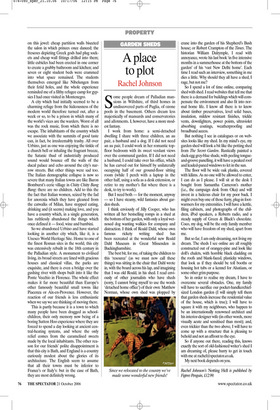A place to plot
Rachel Johnson
Some people dream of Palladian mansions in Wiltshire, of third homes in undiscovered parts of Puglia, of ozone pools in the basement. Others dream less majestically of mansards and conservatories and allotments. I, however, have a more modest fantasy.
I work from home: a semi-detached dwelling I share with three children, an au pair, a husband and a dog. If I did not need an au pair, I could work in her romantic topfloor bedroom with its sweet verdant views over the communal garden. If I did not need a husband, I could take over his office, which he has carved out for himself by unilaterally occupying half of our ground-floor sitting room (while I perch with a laptop in the other half, using a sofa as a desk extension, or retire to my mother’s flat where there is a desk, to try to work).
But I need both — for the moment, anyway — so I have steamy, wild fantasies about garden sheds.
I think enviously of Jilly Cooper, who has written all her bestselling romps in a shed at the bottom of her garden, with only a loyal wetnosed dog wanting walkies for company and distraction. I think of Roald Dahl, whose own famous rickety writing shed has been recreated at the wonderful new Roald Dahl Museum in Great Missenden in Buckinghamshire.
The best bit, for me, of taking the children to this ‘resource’ (as we must now call these things) was sitting in the chair that Dahl wrote in, with the board across his lap, and imagining that I was old Roald, in his shed. I read enviously of other journalists who have sheds (sorry, I cannot bring myself to use the words ‘detached home office’) of their own: Matthew Norman, whose own shed was plopped by crane into the garden of his Shepherd’s Bush house; or Robert Crampton of the Times. The historian William Dalrymple, I read with annoyance, wrote his last book ‘in five intensive months in a summerhouse at the bottom of the garden’ of his ‘vast New Delhi home’. Each time I read such an interview, something in me dies a little. Why should they all have a shed, I rage, but not me?
So I spend a lot of time online, comparing shed with shed. I read websites that tell me that there is a demand for buildings which will compensate the environment and also fit into normal home life. I know all there is to know about timber preservatives, level solid bases, insulation, mildew resistant finishes, trickle vents, downlighters, power points, ultraviolet absorbing coatings, weatherproofing and broadband access.
But nothing I see in catalogues or on websites looks like my shed. In my mind’s eye, my garden shed will look a bit like the potting shed from The Secret Garden. Rustically painted a duck-egg grey-blue shade, with peeling tongueand-groove panelling, it will have a peaked roof and leaded-paned windows to let in the sun.
The floor will be wide oak planks, covered with kilims. As no one will be allowed to enter, I can do as I please. I will sit at the desk I bought from Samantha Cameron’s mother (i.e., the campaign desk from Oka) and will invest in a hideous chair for my poor back. I might even buy one of those furry, plug-in footwarmers for my extremities. I will have a kettle, filing cabinets, and photographs of the children, iPod speakers, a Roberts radio, and a steady supply of Green & Black’s chocolate. Coco, my dog, will be the only family member who will have freedom of my shed, apart from me.
But so far, I am only dreaming, not living my dream. The sheds I see online are all roughly constructed out of orangey-pine and look like doll’s chalets, with horrible black cladding on the roofs and blank-faced, plasticky windows, that look as if they should be toll booths or housing hot tubs or a kennel for Alsatians, or some other grim purpose.
So in order to realise my dream, I have to overcome several obstacles. One, my family will have to sacrifice our pocket-handkerchiefsized London garden (I will simply tell them that garden sheds increase the residential value of the house, which is true); I will have to square it with my neighbours, who happen to be an internationally renowned architect and his interior-designer wife (in other words, more visually acute and sensitised than most); and, even trickier than the two above, I will have to come up with a structure that is pleasing to behold and not an affront to the eye.
So if anyone out there, reading this, knows exactly the sort of old-fashioned writer’s shed I am dreaming of, please hurry to get in touch with me at rachel@spectator.co.uk.
My next book depends on you.


































































































 Previous page
Previous page